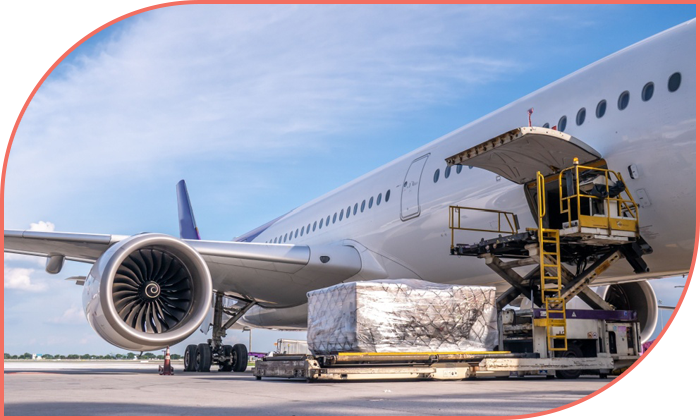Air Freight Shipping
Air freight, also known as air cargo, refers to the transportation of goods via aircraft. Items are typically handled by specialised cargo airlines or the cargo holds of passenger planes.
Industries requiring just-in-time inventory management can receive perishable items, high-value products and fragile goods within just a few days. It’s this quick delivery that makes air freight shipping such an efficient method of transport.
Air freight quotes are subject to certain conditions, such as the weight and dimensions of your shipment, perishability (e.g., temperature-sensitive goods or pharmaceuticals) and fuel prices.
How does the air freight shipping process work?
1. Booking and documentation
The process begins with booking your shipment with a qualified air freight provider.
At this stage, you need to prepare and submit all necessary documentation, including commercial invoices, packing lists, and air waybills (AWB). These documents are essential for tracking and customs clearance purposes.
2. Cargo handling at origin
Once your shipment is booked, the cargo needs to be properly packed and labelled.
Cargo handling involves placing the goods onto skids or pallets and ensuring they are securely wrapped to prevent damage. The goods are then transported to a cargo terminal, where they undergo inspection and weighing.
3. Customs clearance and security checks
Before the cargo can be loaded onto an aircraft, it must clear export customs.
To do this, the shipment’s details and compliance with international shipping regulations should be verified. Security checks are also conducted to make sure the cargo doesn’t contain prohibited items.
4. Transportation to airport
After passing security and customs checks, the cargo is transported to the airport. The goods must be coordinated with local transport services so that the goods can be moved from the warehouse to the airport terminal.
5. Loading onto the aircraft
At the airport, specialised equipment and handlers load the cargo onto the aircraft.
6. In-flight air freight shipping
During the flight, the cargo remains secure and is monitored to observe its condition. Air freight is known for its high traceability, with planes providing shippers real-time updates on the cargo’s location.
7. Arrival and import customs clearance
Upon arrival at the destination airport, the cargo undergoes import customs clearance. Another round of document verification and inspections will be conducted to verify compliance with the destination country’s import regulations.
8. Final delivery
Once the cargo has cleared customs, it’s transported to the final destination. Additional ground transportation services may be required to deliver the goods to the consignee’s address.
Compare Air Freight Shipping Rates in Seconds
Get instant quotes from leading air freight providers. Find the best rates for your shipping needs in one place.
How should I prepare my goods for air freight?
1. Proper packaging
To prepare goods for the rigours of air transport, shippers should use sturdy boxes and, for fragile items, bubble wrap and padding to prevent damage.
Goods should be packed tightly to avoid movement during transit, and for larger shipments, consider using palettes that are wrapped and well-secured.
2. Labelling
Label your packages clearly with all necessary information, including the sender’s and recipient’s addresses, contact numbers, and any special handling instructions.
It’s advisable to include a duplicate label inside the package in case the outer label gets damaged.


3. Documentation
Prepare all necessary shipping documents.
Typically, you will need a commercial invoice, packing list, and airway bill (AWB). If you are shipping hazardous materials, a Dangerous Goods Note (DGN) detailing how to handle and transport the items safely is required.
4. Compliance with regulations
You should make certain your shipment adheres to customs requirements for both the origin and destination countries.
For the UK, you must make an export declaration and possibly a transit declaration. Detailed information about these requirements can be found here.
5. Insurance
Consider obtaining insurance for your shipment to protect against potential loss or damage during transit: this is especially important for high-value or sensitive goods.
What documentation is required to ship cargo by air?
1. Commercial Invoice
The commercial invoice provides a detailed account of the transaction between the shipper and the buyer.
It includes descriptions of the goods, their value, quantity, and terms of sale. Customs authorities use commercial invoices to assess import duties and taxes.
2. Air Waybill (AWB)
The AWB is a non-negotiable document issued by the airline or freight forwarder. It establishes a contract of carriage between the two parties by laying out the terms and conditions of transport.
The AWB includes information such as the shipper's and consignee's details, the origin and destination of the shipment, and a description of the goods.
3. Packing list
The packing list describes the shipment's contents, including itemised details such as each item's dimensions, weight, and packaging type.
The packing list helps customs officials and warehouse personnel verify the accuracy of the shipment.
4. Certificate of origin
Shippers considering the cost of air freight rates should also factor in the certificate of origin, which declares the country where the goods were manufactured.
It’s vital for customs clearance and determining eligibility for preferential duty rates under free trade agreements.
What are the different types of air freight services?
Understanding the two primary types of freight transportation – commercial and cargo airlines – is essential for an in-depth understanding of air freight comparison.
1. Commercial airline
Commercial airlines primarily transport passengers, but they also offer cargo services using the available space in the aircraft's belly hold.
2. Cargo airline
Cargo airlines, also known as freighters, are dedicated entirely to transporting goods. These airlines operate aircraft specifically designed or modified to carry cargo.

What are the transit times for air freight?
How long does air freight take from China to the UK?
Generally, air freight from China to the UK can take 8 to 10 days.
How long does air freight take from the UK to the USA?
Air freight travelling from the UK to the USA can take 10 to 12 days.
Find the Lowest Air Freight Rates Today
Compare shipping quotes from trusted providers. Get the best deals on air freight.
What do you need to take into consideration when shipping goods via air freight?

1. Emissions: Air freight is known for its higher carbon emissions compared to sea or rail shipping. Businesses looking to reduce their environmental impact may need to weigh the benefits of air freight’s speed and reliability against its CO2 production.
2. Heavy/bulk goods: Air freight is typically more suitable for smaller, high-value, or time-sensitive shipments.
Due to space and weight limitations, air freight can become less practical for heavy or bulky goods. Cargo planes have specific restrictions on the size and weight of shipments they can handle.
3. Cost: International air freight is generally the most expensive mode of transport due to factors like fuel prices, handling fees, and the premium charged for faster delivery times. Air freight costs are calculated based on chargeable weight, which takes into account both the actual weight and the volumetric weight of the cargo. It’s because of this that costs for bulky but lightweight items can significantly increase.
Frequently Asked Questions
How much does air freight cost per kg?
The cost of air freight per kilogram varies depending on several factors, including the origin and destination of the shipment, the type of cargo, and current market conditions. Air freight rates can increase during peak periods or due to specific market disruptions.
Air freight vs sea freight: which is best for my shipment?
Choosing between air freight and sea freight depends on various factors, including cost, speed, and the nature of your cargo.
Find the best air freight rates with Freight Broker!
With Freight Broker’s competitive air freight quotes, you can get the best possible shipping deals. Our quick and easy-to-use air freight comparison service will show you affordable rates, low prices and quick delivery times. So, if you’re ready to receive your goods on time, compare prices with Freight Broker!